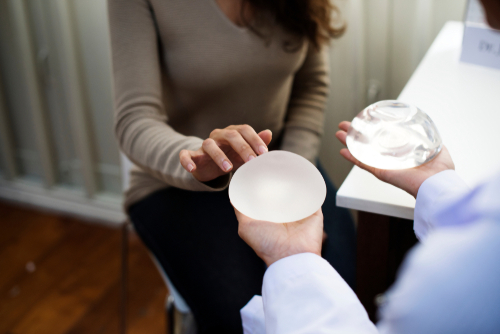Click here for a Free Online Breast Augmentation Self Evaluation
What is the right implant choice for my augmentation?
Fortunately today, the prospective breast augmentation patient has many choices. There’s no “best” choice of implants. Based on your individual needs, wants and desires there is, however, an “optimal” choice. The following will hopefully help you become better educated and aid you in your decision process.
All breast implants sold in the United States are highly regulated and have undergone extensive and rigorous testing by the Federal Drug Administration (FDA) and are deemed safe for human implantation. We’ll present a brief overview of the implant fillers, profiles and shapes as well as the different breast implant manufactures.
In addition saline breast implants have been implanted for over 50 years with no long-term health issues yet identified from the filler material (silicone or saline). Specifically, there’s no increased incidence of breast cancer with patients who have undergone breast implant surgery.
In fact, women who develop breast cancer who have undergone a breast augmentation with breast implants are diagnosed at an earlier stage (breast cancer found earlier or smaller). This has been theorized that because the implant is under the breast tissue, it makes it easier to examine the breast tissue.
However, recent data has shown a very rare (less than 40 reported cases) type of non-breast cancer (anaplastic large-cell lymphoma) associated with older-textured breast implants. The FDA has only recommended close surveillance of patients with older textured breast implants and doesn’t recommend prophylactic removal of the implants.
Silicone- and saline-filled implants are both devices that have their inherent differences and nuances.
Implant Filler Material
Implant Profile
For the same volume, the higher the profile the narrower the base width. There’s very little difference in projection between a moderate to high profile implant, thus little effect on how the actual nipple will look. The base width of the breast should equal the base width of the implant. Thus I personally chose the profile based on the patient’s chest measurements. (A high profile on a wide chest may not result in the cleavage desired, and conversely a low profile on a narrow chest may result in implant in the outside arm). Cleavage is largely determined by your anatomy. This can be optimized by choosing the most accurate-fitting profile implant for your specific anatomy (based on measurements) and postoperative implant displacement exercises.
Shape
- Round — most often used in elective cosmetic breast augmentation. The implants move and feel like breast tissue.
- Shaped — also known as “anatomical” implants and are form-stable, thus a bit stiffer to feel and usually used in reconstructive breast surgery. (This is because of the breast tissue loss and resulting tighter skin; the “anatomical’ form-stable implants will retain a more normal-appearing breast shape.)
Implant Manufacturers
There are four companies that produce breast implants:
1. Mentorasa
2. Allergan
3. Sientra
4. Ideal
1-2 – silicone gel fill comes from same factory
2 – silicone gel has highest cohesiveness (gummy bear) for round implants
1 – only implants made in the U.S.
1-2 – make both silicone- and normal saline-filled implants
4 – makes normal saline-filled implants
4 – has internal baffles in normal saline implant to feel more like silicone-filled implants
1-4 – all FDA-approved with lifetime warranties
1-3 – have a capsular contracture warranty (manufacturer will replace implants without cause)
1-3 – have different profiles (for same volume but different base widths) resulting in different projections
1-3 – have anatomical or shaped implants
I hope you found this information helpful as you make your decisions.
